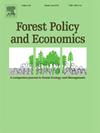A mathematical model for strategic management of the forest supply chain considering its products and energy generation
IF 3.8
2区 农林科学
Q1 ECONOMICS
引用次数: 0
Abstract
Historically, forestry supply chains have operated in a disjointed manner, leading to insufficient coordination between forest management and wood processing in their planning and operations. In addition, generating energy using the available resources of the forestry activity has been largely considered a secondary activity, with slight synchronization with the remaining chain. However, currently, comprehensive supply chain integration is essential for guaranteeing the economic sustainability of forest supply chains. This article presents a multi-period mixed integer linear programming (MILP) model for forest resource management, covering everything from harvesting to energy generation. It considers supply chain planning, customer selection, and both internal and external raw material sources. The model considers transportation costs, production limits, and the use of specific equipment for processing biomass and industrial waste. Importantly, it includes bioenergy generation, highlighting its economic advantages and role in the overall management of forest supply chains. Analysis of a real-world case from Misiones, Argentina, reveals that meeting wood demand consistently necessitates the exploitation of external forest stands. Moreover, the integration of on-site waste processing equipment within the stands proves economic benefits for the supply chain, whereas incorporating units for processing pulpable logs yields a comparatively smaller economic return. Notably, the study indicates that satisfying potential increases in energy demand is largely contingent on the availability of waste from external sawmills. However, in instances where external sawmill waste is scarce, the plant maintains operational continuity by utilizing alternative byproducts, such as forest biomass chips, which are typically designated for sale.
考虑其产品和能源产生的森林供应链战略管理的数学模型
从历史上看,林业供应链以脱节的方式运作,导致森林管理与木材加工之间在规划和运营方面的协调不足。此外,利用林业活动的现有资源生产能源在很大程度上被认为是次要活动,与其余的链条几乎没有同步。然而,目前,全面的供应链整合是保证森林供应链经济可持续性的必要条件。本文提出了一个森林资源管理的多周期混合整数线性规划(MILP)模型,涵盖了从采伐到能源生产的所有环节。它考虑供应链规划,客户选择,以及内部和外部原材料来源。该模型考虑了运输成本、生产限制以及处理生物质和工业废物的特定设备的使用。重要的是,它包括生物能源发电,突出了其经济优势和在森林供应链整体管理中的作用。对阿根廷米西奥内斯一个现实案例的分析表明,为了满足木材需求,必须不断开发外部森林。此外,在展台内整合现场废物处理设备证明了供应链的经济效益,而合并处理可碎原木的设备产生的经济回报相对较小。值得注意的是,该研究表明,满足能源需求的潜在增长在很大程度上取决于外部锯木厂废物的可用性。然而,在外部锯木厂废物稀少的情况下,工厂通过利用替代副产品,例如通常指定出售的森林生物质碎片,保持业务连续性。
本文章由计算机程序翻译,如有差异,请以英文原文为准。
求助全文
约1分钟内获得全文
求助全文
来源期刊

Forest Policy and Economics
农林科学-林学
CiteScore
9.00
自引率
7.50%
发文量
148
审稿时长
21.9 weeks
期刊介绍:
Forest Policy and Economics is a leading scientific journal that publishes peer-reviewed policy and economics research relating to forests, forested landscapes, forest-related industries, and other forest-relevant land uses. It also welcomes contributions from other social sciences and humanities perspectives that make clear theoretical, conceptual and methodological contributions to the existing state-of-the-art literature on forests and related land use systems. These disciplines include, but are not limited to, sociology, anthropology, human geography, history, jurisprudence, planning, development studies, and psychology research on forests. Forest Policy and Economics is global in scope and publishes multiple article types of high scientific standard. Acceptance for publication is subject to a double-blind peer-review process.
 求助内容:
求助内容: 应助结果提醒方式:
应助结果提醒方式:


